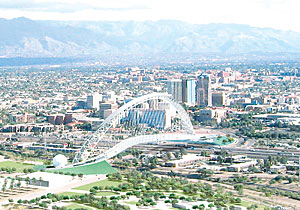 |
|
Image courtesy of Rafael Viñoly Architects
|
The University Science Center may move to an observatory at the base of the future UASC Rainbow Bridge, planned to be constructed downtown at cost of upward of $100 million.
|
|
|
By Mitra Taj
Arizona Daily Wildcat
September 2, 2005
Print this
More ambitious plans for the proposed University Science Center, a focal project of the downtown rejuvenation project Rio Nuevo, could turn the Flandrau Science Center's replacement into a potential city landmark.
Since the university and city contracted New York-based Rafael Viñoly in June as chief architect for the University Science Center, plans for the center have grown to include a 360-foot-high bridge arching over Interstate 10, likened in importance to St. Louis' Eads Bridge.
Viñoly's vision could mean a higher price tag for the science center, projected in September 2003 to cost the city and university $100 million.
Viñoly was out of town and unavailable to answer questions this week.
Saturday the Arizona Daily Star reported Viñoly estimated the cost of the project could be more than double the original $100 million projection.
President Peter Likins said Viñoly's doubling the cost of the project was only an estimate that shouldn't replace conclusions an economic feasibility will produce this month.
"That was a wild, wild number," Likins said. "The reality is the science center began as a University of Arizona transfer of Flandrau into Rio Nuevo. As the architects began talking, the concept grew into something much more than just a science center."
It is typical for cost estimates to fluctuate throughout the design process for new buildings, usually going up from original projections, said Senior Vice President of Business Affairs Joel Valdez.
"We start out with a certain estimate of the price, then it's designed, and then it's bid on, and then you find out what the real price is," Valdez said.
Valdez said with construction prices rising, it's likely the project will cost more than expected two years ago.
The university and City of Tucson hope the center, which would replace and expand on the functions of the phased out Flandrau Science Center and Planetarium, will attract more of Tucson's non-university community to its informal educational science programs.
"Frankly, Flandrau is kind of bound to campus, and only youngsters who can find their way here have the opportunity to see the richness of what Flandrau can offer," Likins said. "We need to go to where the people are."
The University Science Center buildings would form part of the bridge linking the east and west sides of Rio Nuevo. It also includes a pedestrian path and a rooftop café. The center would feature an observatory, a butterfly vivarium, a giant screen theater and a digital planetarium.
The project needs further approval, however, from the Arizona Board of Regents, the Rio Nuevo multi-purposes facilities district board, and the Tucson and Mayor Council.
Likins said it's important for the proposed center to be right for the community it's serving.
"I find the architect's vision very intriguing," Likins said. "What I don't know is if the community of Tucson has the will or resources to make a statement of this nationally visible character."
If approved, work could begin as early as late 2006 and could be finished by 2009, said Rob Vugteveen, director of marketing and outreach for Flandrau.
Vugteveen said both the broader Tucson community and the university will benefit from the science center's new role.
"In order for the university to succeed, the city has to succeed," Vugteveen said. "This will provide a way for people to know how we contribute to the state," as a land grant institution.
In 2003, Flandrau was one of seven university programs slated for elimination as a part of Focused Excellence, university administration's plan to focus resources in university strengths.
Later that year, Rio Nuevo offered to take the center in as a downtown science center, and university administration agreed to reduce its budget until the transfer was made.
The Arizona Board of Regents gave the university approval to buy $56.1 million in certificates of participation, similar to bonds. Private donations and revenues made from the hundreds of thousands of visitors the center expects to draw in annually would service that debt over the next 30 years, Vugteveen said.
Assets from the closing Flandrau would provide additional university funding for the center. About $26 million from the budget of Rio Nuevo and private donations will provide the remaining, Vugteveen said.
Likins said the university is not going to ask the regents to approve more university funding for the center.
"We're not in the position to go beyond that," Likins said.
Regent Fred Boice, a former UA graduate student who lives in Tucson, said if the project ends up costing a lot more than the original $100 million projected, he'd have "difficulty" in approving more funding for it.
"I think there's a limit to what we can do. There's a limit on what we can bond," Boice said. "The university stepped up early as a vote of confidence for Rio Nuevo ... but every pocket's got a bottom to it."
Boice said while Flandrau has been an important player in the university's community outreach, the proposed science center would be a better way for the university to keep up with the changing city of Tucson.
"If you're not doing better, you're doing worse," Boice said. "I think it's important that the university is an integral part of Rio Nuevo."
Viñoly's past projects include New York's Jazz at Lincoln Center, the Tokyo International Forum and a bridge for Pennsylvania State University.
"The concept is changing as we watch it, and it's far too soon to know if that's going to be a concept we buy into, or, if we go back to the Science Center as a building on the east side of the freeway," Likins said.
Flandrau Executive Director Alexis Fuast did not respond to phone calls before press time.
